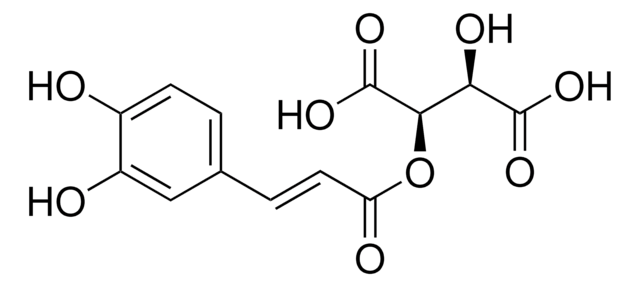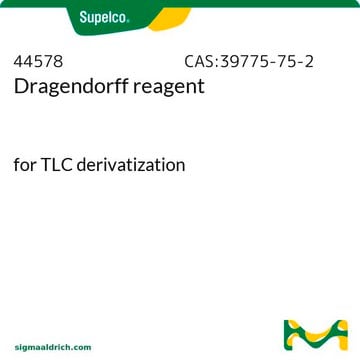15029
Caftaric acid
≥97.0%
Synonym(s):
2-Caffeoyl-L-tartaric acid
About This Item
Recommended Products
Assay
≥97.0%
form
powder
impurities
≤10% water
application(s)
metabolomics
vitamins, nutraceuticals, and natural products
storage temp.
2-8°C
SMILES string
O[C@H]([C@@H](OC(=O)\C=C\c1ccc(O)c(O)c1)C(O)=O)C(O)=O
InChI
1S/C13H12O9/c14-7-3-1-6(5-8(7)15)2-4-9(16)22-11(13(20)21)10(17)12(18)19/h1-5,10-11,14-15,17H,(H,18,19)(H,20,21)/b4-2+/t10-,11-/m1/s1
InChI key
SWGKAHCIOQPKFW-JTNORFRNSA-N
Looking for similar products? Visit Product Comparison Guide
General description
Application
- as a standard antioxidant to determine the antioxidant potential (AOP) of red wine using 2,2-diphenyl-1-picrylhydrazyl (DPPH) assay
- as an antioxidant together with sulfur dioxide (SO2) to measure the antioxidant potential of white wines using 2,2-diphenyl-1-picrylhydrazyl (DPPH) and Folin-Ciocalteu (FC) assays
- to evaluate the myelopoietic effect on bone marrow of rats treated with various Echinacea purpurea extracts
- to identify (poly)phenolic compounds in concord grape juice and their metabolites in human plasma and urine after juice consumption
Biochem/physiol Actions
Packaging
Storage Class Code
11 - Combustible Solids
WGK
WGK 3
Flash Point(F)
Not applicable
Flash Point(C)
Not applicable
Personal Protective Equipment
Certificates of Analysis (COA)
Search for Certificates of Analysis (COA) by entering the products Lot/Batch Number. Lot and Batch Numbers can be found on a product’s label following the words ‘Lot’ or ‘Batch’.
Already Own This Product?
Find documentation for the products that you have recently purchased in the Document Library.
Customers Also Viewed
Protocols
HPLC Analysis of Polyphenols in Nero d'Avola Red Wine on Discovery® HS C18 (UV 280 nm)
Our team of scientists has experience in all areas of research including Life Science, Material Science, Chemical Synthesis, Chromatography, Analytical and many others.
Contact Technical Service













